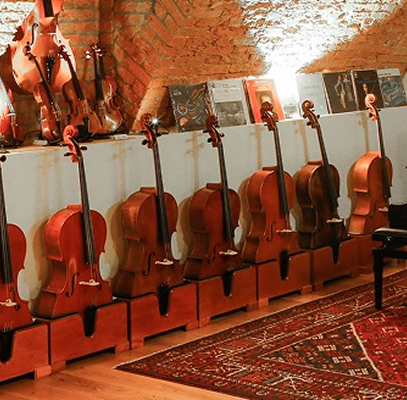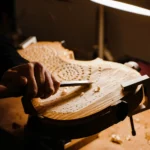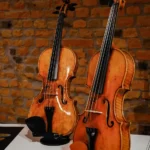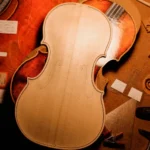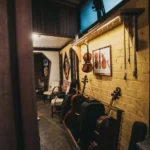Amati Viola and Fine Instruments: Craftsmanship and Heritage
Back to BlogAmati Viola and Fine Instruments
Andrea Amati, the father of the world of violin-making, founded a legacy that has spanned generations and has created the foundation for the world-renowned Cremonese violin-making tradition. But did you know that Amati is also considered one of the creators of the modern viola as we know it today? In this blog, we will explore the importance of the Amati viola and the heritage he and his family left behind with their fine instruments.
Andrea Amati’s instruments are revered for their historical significance and meticulous craftsmanship. He is often referred to as the “father of the violin” due to his role in refining the design and construction of the instrument we know today and also most likely due to making the oldest violin in existence today. Amati’s instruments have a distinct style characterized by elegance and precision, setting the standard for future generations of luthiers.
Amati’s legacy extended beyond his workshop, influencing the work of his successors, including his sons, grandson, and the famed Stradivari and Guarneri families.
The Amati Legacy
Andrea Amati was born in Cremona, Italy, around 1505. Little is known about his early life and how he became a luthier. He probably started working independently as a luthier around 1525. By February 1539, he could buy a property in the center of Cremona that would become the house and workshop of his family for more than two hundred years.
He had two sons, Antonio and Girolamo, also known as the ‘Amati Brothers,’ who inherited the workshop in the late 1570s. Girolamo’s son, Nicolò, took on a central role in the shop after 1620 and had many highly regarded apprentices, including Antonio Stradivari and Andrea Guarneri.
Apart from creating the first four-stringed, violin-like instrument, Andrea Amati is also credited with producing the first modern-shaped viola (along with Gaspare da Salo of Brescia). The first violins made by Amati were a little smaller than modern violins, with high arches, wide purfling, and elegantly curved scrolls and bodies. His two sons, Antonio and Girolamo, developed and strengthened their father’s models, using an experimental approach and making violins, violas, and cellos in many different sizes to perfect the tonal quality. Nicolò Amati’s instruments were wider than other makers’ instruments, with beautifully shaped soundholes and strong tonal qualities. This design is now known as the ‘Grand Amati.’
Amati Violas: Craftsmanship and Design
Amati violas are credited with being the first modern-shaped violas, most similar to the instruments we play today. His violas were small elegant, with high tonal qualities and a superior sound. His sons, the ‘Amati Brothers,’ experimented with the body and belly’s shape without changing the sound quality and elegance of their father’s instruments.
These instruments’ superior tonal quality and elegance made them famous around European courts. Catherine de Médicis, the regent queen of France, ordered many of Andrea Amati’s instruments for her son Charles IX of France. The instruments made by the Amati family were soon all around Italy and Europe; their incomparable look and perfect construction features made the models that have been used for centuries and that determine the quality of an instrument.
The Appeal of Fine Instruments
These fine instruments, like Amati violas, carry a rich history and provenance that sets them apart as the pinnacle of craftsmanship and artistry. They were crafted using techniques from centuries ago, using meticulous attention to detail; they are not only masterpieces but also cherished heirlooms that have been passed down through generations.
Owning one of these instruments is the preferred choice for discerning musicians and collectors due to their exceptional tonal qualities, unparalleled responsiveness, and exquisite beauty. They will increase their value over time and, therefore, are an excellent sound investment. As a fine viola ages, its rarity and historical significance increase, making it highly sought after on the market. This is also due to the limited supply of this kind of instrument on the market and its enduring reputation. As a result, owning a fine viola is an investment that brings immense musical satisfaction and can offer significant financial gain over time.
Collecting Amati Fine Instruments
Owning and collecting a fine instrument like an Amati viola is any musician and collector’s dream. These instruments were not only crafted by exceptional luthiers but also made with the best materials, using precise craftsmanship, and, consequently, had an incredible sound. They are works of art made centuries ago by the founding family of stringed instruments, and their worth is exponential.
The value of this kind of fine instrument will be based on different factors, including its age, its general condition, and its history (for example, whether it has ever been played by an accomplished musician or used in a prestigious concert or orchestra). Owning such a valuable instrument demands meticulous attention and care to avoid damaging it. It must be stored in optimal conditions with humidity ranging between 50 and 60% and must be cleaned and checked on regularly by an expert luthier.
Notable Amati Violas
Some of the Amati’s most famous violas in history are:
The Witten 1560 by Andrea Amati.
This viola is one of the best preserved of the decorated instruments made by Amati. It features paintings of fleurs-de-lis and trefoils on its back that surround a royal monogram. The Witten viola’s motto on its ribs says, “By this one bulwark religion stands and will stand,” which was most likely made for the marriage of the Spanish king and daughter of the French king to unify the catholic royal courts against Protestantism.
The Girolamo Amati viola 1620 by Girolamo Amati.
This viola is one of the first contralto violas of modern proportions; it underwent minor modifications in the 18th century but still has its original neck. It is currently preserved in the Galleria Estense in Modena. The Girolamo Amati viola is small and, therefore, relatively rare. The body, scroll, and f-holes, as well as the thickness and curvature of the top and back, are the originals made by the master luthier.
The Professor Wirth viola 1663 by Nicolò Amati.
Many musicians have assessed this large viola as tonally superb and one of the finest violas. Once played by Emmanuel Wirth of the Joachim Quartet and professor at the Berlin Hochschule, this viola is now the property of the Smithsonian Institution Museum.
The Professor Wirth viola has a two-piece spruce top of medium gain widening to the edges, which are two-piece back of quarter-sawn maple; the ribs and scroll are of a similar maple, and the varnish is an exquisite orange-brown color over a golden ground. After being played by Professor Wirth, this viola was owned by many people, including collectors, musicians, and museums, before finally finding its home at the Smithsonian Institution Museum.
Romanov viola 1677 by Nicolò Amati.
This viola was made when Nicolò Amati was 81 years old with the help of his son Girolamo Amati II. It was part of the collections of the nobility of Venice and the Russian Imperial dynasty and was played for many years by Max Aronoff with the Curtis Quartet.
The Romanov viola has a particularly charming design, with a look reminiscent of the tenor violas made by Andrea Amati. The shape, carving of the scroll, and design of the f-holes suggest it was made with an archaic approach. It gets its name from the Russian imperial family, as it once belonged to the royal collection of the Romanovs. After the Russian Revolution, it was taken to New York by the tsar’s nephew. Today, it is housed in a private collection.
These violas are iconic not only for their superb sound and craftsmanship but also for their rich historical significance.
Where to Find Amati Violas
With such rich history and cultural importance, Amati violas and fine instruments are not easy to find on the market. Nowadays the most likely place to buy such prized instruments is through auction houses or important fine stringed instrument dealers.
Preserving the Heritage
Of course, due to their important financial worth, Amati fine instruments cannot be owned by most people. However, it is fundamental to preserve these works of art for future generations. Their importance goes beyond their beauty and exceptional sound, they are an essential part of musical history and heritage. They have paved the way for modern luthiers to make their stringed instruments, an Amati viola is not just a musical instrument to be played, it is a masterpiece to be observed, studied and revered.
In order to protect the heritage of fine instruments, it is fundamental to educate people about the importance of buying and owning a traditional handcrafted instrument compared to an industrialized one. By making his exceptional instruments in Cremona, Andrea Amati founded a legacy that has made Cremona the capital of violin making in the world. Nowadays luthiers study, are inspired by and make copies of Amati’s instruments. He put down the techniques of lutherie that are used to this day. Protecting instruments made by the Amati family means protecting traditional handcrafted violin making.
Amati gave us beautiful instruments that we love and cherish today. The Amati violas and fine instruments are not only perfectly made with extraordinary sound but they have paved the way for contemporary musicians and luthiers, they are the bridge between past and present, creating a profound influence on the world of music. Owning one of these instruments is any musician or collector’s dream, but learning about them can also help maintain the importance of this beautiful craft.
Music has the power to create strong emotions and feelings, fine instruments, like Amati’s violas play such enchanting sounds, that they can captivate anyone, whether they are a musical enthusiast or not. Learning about and appreciating these beautiful instruments is fundamental to maintain the legacy and cultural heritage that the Amati family left behind. To know more about the history of violin making, check our blog posts.

